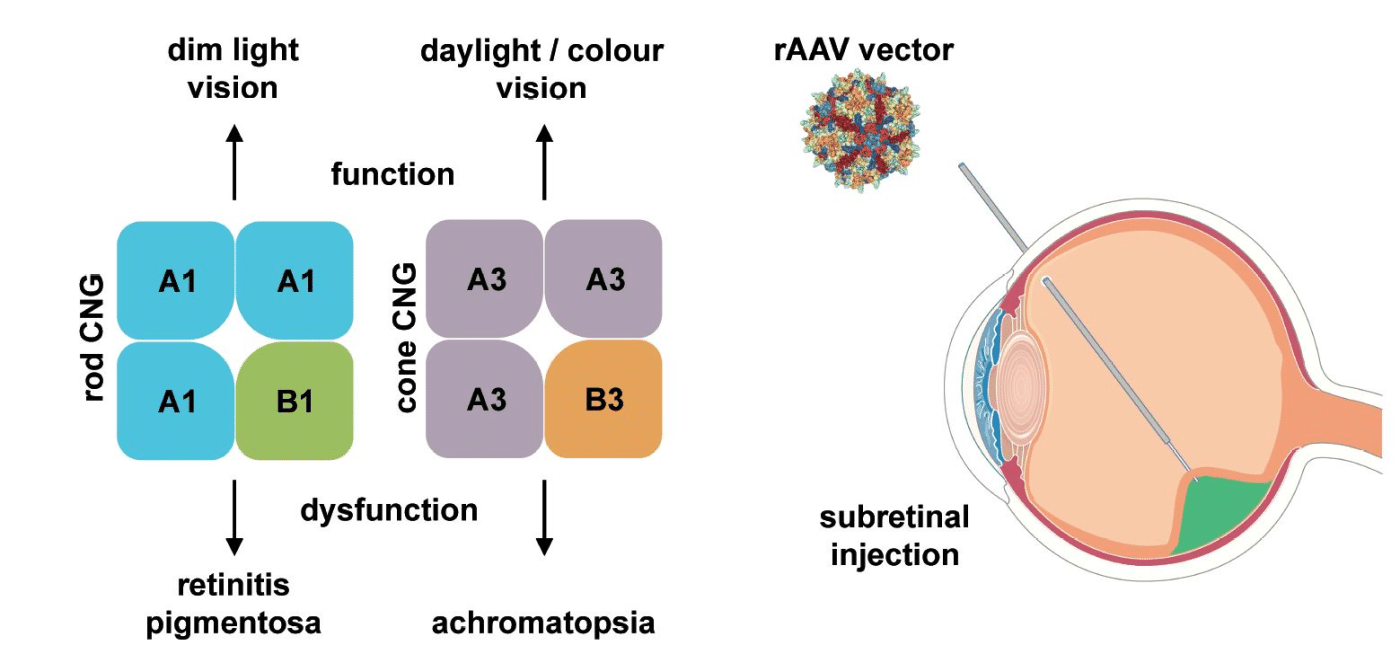People with Achromatopsia are unable to perceive colors or see in bright light, and their vision is often described as being like a black and white photograph. While there is no cure for achromatopsia, there have been significant advances in recent years in terms of research and treatment options.
Living in a World Without Color: Understanding Achromatopsia
Achromatopsia is a rare, non-hereditary condition that causes the complete loss of color vision. People with achromatopsia cannot see color, and they also have low vision.
What caused achromatopsia?
Achromatopsia is caused by defects in the eye that block certain wavelengths of light from reaching the retina. The most common type of achromatopsia is hereditary achromatopsia, which can be passed down from parent to child. It affects about one in every 30,000 people worldwide.
People with achromatopsia are often referred to as “colorblind,” but this isn’t an accurate term because people who have achromatopsia can see some colors and just not others — they may only be able to distinguish between black and white. It doesn’t affect other senses like hearing or touch, but it can make it difficult for people to function normally in everyday life because they’re unable to recognize the different shades of colors that most people take for granted.
What are the typical symptoms?
Achromatopsia is a rare eye disorder that causes vision to be reduced to black and white, with no color vision. It’s also known as achromatopsia simplex and rod monochromacy.
Complete Achromatopsia
Complete achromatopsia is also known as rod monochromacy. The retina contains only rods (cells that detect light), no cones (which detect color). This type of blindness is usually present at birth and affects both eyes equally. People with complete achromatopsia cannot see any colors at all, but they do have some limited visual acuity. For example, they may be able to read large letters on an eye chart but not small ones. The severity of this condition varies from person to person; some people are able to differentiate between different shades of gray while others cannot tell the difference between red and green.
Incomplete Achromatopsia
Incomplete achromatopsia is much more common than complete achromatopsia. It’s estimated that 1 in every 33,000 people in the United States has this type of the disease.
People who have this type of the condition may be able to see some colors but not others. For example, they might only be able to distinguish between green and blue objects since these colors stimulate cones in their retina more strongly than other colors do.
Researchers have made some progress in understanding how achromatopsia develops in the eye and brain, but they still don’t know how to treat it. However, there are some promising developments on the horizon: Researchers have found ways to treat incomplete achromatopsia using gene therapy or stem cell transplants, and they’re working on treatments for complete achromatopsia as well.
How is achromatopsia diagnosed?
Achromatopsia is usually diagnosed during infancy or early childhood. It can be identified by abnormal eye movements and abnormal pupil responses to light. This can be confirmed by an electroretinogram (ERG), which measures how well your eye converts light into electrical signals.
Recent Research on Achromatopsia
Achromatopsia is caused by the absence of one of the three cone photopigments (which are responsible for perceiving short-wavelength light), thus causing color blindness. In most cases, it’s caused by a mutation in the CNGA3 gene, which codes for the alpha-subunit of rod cGMP-gated channels. These channels regulate the amount of calcium ion influx into rod cells, which affects their sensitivity to light.

Researchers have found that some patients with achromatopsia may have different mutations in the CNGB3 gene instead; these mutations affect two other proteins, which are necessary for normal vision development and function.
In the past decade, there have been numerous studies on the genetic basis of achromatopsia, leading to a better understanding of how the condition develops and progresses. Researchers have identified specific genetic mutations that are responsible for the disorder, and are now working to develop targeted therapies to correct or mitigate these mutations.
One promising treatment option is gene therapy. the FDA approved the first gene therapy for an inherited disease, Luxturna, which is used to treat a form of inherited blindness. Similar approaches are now being tested for achromatopsia. Gene therapy involves delivering a healthy version of the mutated gene into the cells of the retina, with the aim of restoring color vision. This type of treatment has shown promising results in clinical trials, with some patients experiencing significant improvements in color vision.
Some forms of achromatopsia can be treated with glasses or contact lenses that change the way light enters the eye and stimulates cone cells (called visual aids). However, these options don’t work well for everyone because they don’t compensate for all aspects of light sensitivity and can cause side effects such as headaches and dizziness..
How Gene Therapy Works for Achromatopsia
In December 2018, researchers from Italy’s University of Genoa announced they were able to successfully treat a mouse model of achromatopsia using gene therapy. They used an adeno-associated virus (AAV) vector to deliver a normal copy of the LCA3 gene into the retina. This effectively restored vision in mice with achromatopsia, according to the study published in Science Translational Medicine.
Gene therapy uses genetic material to treat or prevent disease by inserting it into cells in hopes of correcting genetic defects or deficiencies. Gene therapy has been used on humans since 1990, with more than 350 clinical trials being conducted worldwide today.
Other Potential Treatments
There is currently no treatment for achromatopsia. However, there are a few experimental treatments being tested in animals that may help restore some of the visual function lost due to this condition.
Cone implant replacement technology (also known as CIRIT). This technology uses electronic devices designed to replace damaged cones in the eye. The device works by stimulating remaining cones into sending signals to the brain about color, thereby restoring some of the lost color perception associated with achromatopsia.
One potential treatment involves transplanting light-sensitive cells (called photoreceptors) from a donor animal into an achromatopic animal’s eyes. The transplanted cells will be able to form new connections with existing neurons in the eye and restore some sight. This technique has been successful in restoring partial vision in dogs who have been blinded by cataracts.
Another treatment involves gene therapy which uses genes to correct certain defects in the retina of an achromatopic patient’s eyes. A gene called RPE65 helps produce what are known as retinoids – substances that are essential for normal vision. In people with achromatopsia, mutations in the RPE65 gene disrupt how it works and prevents production of adequate amounts of retinoids that are needed for proper vision. Gene therapy could potentially correct these mutations and allow patients’ retinas to produce enough retinoids so they can see again.
However, both of these treatments are still being tested and require more research before they become available for use on humans
Red-green color blindness and Achromatopsia

Achromatopsia and red-green color blindness are not the same thing. People who are red-green color blind can usually see some shades of green and some shades of red, but they may not be able to tell them apart from other colors such as blue or yellow. Someone with full color vision would see all green objects as having the same shade of green while someone with red-green color blindness would see them as having different shades of green depending on their brightness levels.
In contrast, someone with Achromatopsia has no ability to see any color at all — everything appears gray or black and white.
Child And Achromatopsia
Generally children with chromatopsia have reduced eyesight (20/300 or less), no color perception and light sensitivity (photophobias), nystis and swollen eyelids. Achromatopsia is sometimes known as Day Blindness as they can be more visible under a quiet lighting. Children with incomplete achromatopsis usually have better sight (20/20120 to 20/2080) and usually lack serious visual symptoms. Another issue with children is that it can appear paradoxical, constricted pupils in the darkness usually have hyper-opic refractive errors. Nystagmus and photosyphophobia are usually spotted at the beginning of their development and can improve gradually over time.
Career And Educational Opportunities

Achromatopsia can have an impact on an individual’s career and educational opportunities, as color vision is an essential aspect of some professions, such as graphic design, art, and photography. In some cases, individuals with achromatopsia may have difficulty distinguishing between colors, making it challenging to work with color-coded systems or reading color-coded maps. However, with appropriate accommodations and assistive technology, individuals with achromatopsia can pursue a wide range of careers and educational opportunities.
What is the cost of treatment for achromatopsia?
The costs of treatment for achromatopsia vary greatly depending on the severity of the condition, the age of the patient, and whether or not they are covered by insurance.
A child with achromatopsia may require special schooling and tutoring. They may also need speech therapy to help them learn to speak. This can be very expensive, especially as it is not usually covered by insurance.
There is no cure for achromatopsia but there are treatments that can reduce symptoms such as diuretics and steroids which help with fluid retention. These medications may be prescribed by an ophthalmologist or other specialist physician but they can have side effects if used long term so they are often used in conjunction with other medications like beta blockers or antihistamines. These medications will also incur a cost to the patient and their family but this cost varies according to insurance coverage and whether or not there are any co-pays associated with their use.
Why do people with achromatopsia wear red-green glasses?
People with achromatopsia have difficulty seeing red and green. This is because the cone cells in their retina are nonfunctional.
Cones are responsible for color vision, but people with achromatopsia have damaged cones and cannot see red or green.
In order to compensate for this deficiency, they must wear special glasses that filter out all wavelengths except for red and green. This allows them to perceive those colors more accurately than if they were not wearing the glasses. These glasses are called “red/green” glasses, or “blue/yellow” glasses.
Red-green glasses will not make everything appear as bright as it does for someone with normal vision, but they do allow you to see more colors than before wearing them
How much do achromatopsia glasses cost?
The cost of achromatopsia glasses depends on the type of lens used. Most insurance plans do not cover the cost of glasses, so you will have to pay for them out-of-pocket.
The glasses are made from special materials that absorb certain wavelengths of light, allowing you to see only certain colors. These glasses help people with achromatopsia to see more clearly and distinguish between shades of color.
The price of these glasses varies depending on the type of lens used and its level of customization. The most basic lenses start at around $50 but can cost upwards of $1,000 for more customized options.
Conclusion
Living with achromatopsia can be challenging, but the latest research offers hope for the future. While there is no cure for the condition at present, gene therapy and other potential treatments are showing promise in improving color vision and overall quality of life for those with the condition. As researchers continue to make strides in this area, it is important for individuals with achromatopsia to stay informed about the latest developments and to work with their doctors to explore all available treatment options. Together, we can work to build a better future for those with achromatopsia.
Frequently Asked Question
How does achromatopsia differ from other forms of color blindness?
Achromatopsia is a rare genetic disorder that affects an individual’s ability to perceive color. Unlike other forms of color blindness, such as red-green color blindness, which are caused by problems with the photopigments in the eye, achromatopsia is caused by the absence or malfunctioning of the cone cells in the eye that are responsible for color vision.
Can it be inherited from a parent to a child?
Yes, achromatopsia is a hereditary condition that is passed down from parent to child through the inheritance of a mutated gene. Individuals with a family history of the condition are more likely to develop it themselves.
What is gene therapy being used to treat?
Gene therapy is a novel treatment approach that involves replacing or repairing a faulty gene with a healthy one. In the case of achromatopsia, gene therapy involves delivering a functional copy of the affected gene to the cone cells in the eye to restore color vision. Several clinical trials of gene therapy for achromatopsia are currently underway, with promising results.
Who is most likely to be affected?
Achromatopsia is a rare condition that affects approximately 1 in 30,000 individuals worldwide. The condition is more common in certain populations, such as the Pingelapese people of Micronesia, where up to 5% of the population is affected.
What can people with achromatopsia do to improve their quality of life?
Individuals with achromatopsia can benefit from making certain lifestyle changes, such as avoiding bright lights and wearing appropriate eye protection when necessary. Accommodations, such as using specialized computer monitors and lighting, can also improve visual function.
What challenges do people who have achromatopsia face in everyday life?
Individuals with achromatopsia face numerous challenges in everyday life, including difficulty with tasks such as driving, recognizing faces, and performing outdoor activities. These challenges can be overcome through the use of visual aids and specialized training programs.
Can contact lenses or corrective eyewear help see in color?
Yes, Contact lenses or corrective eyewear cannot help individuals with achromatopsia to see in color, as the condition affects the underlying function of the retina and optic nerve.
Are there any support groups or advocacy organizations?
Yes, there are support groups and advocacy organizations for individuals with achromatopsia and their families, such as the National Organization for Albinism and Hypopigmentation (NOAH) and the Achromatopsia Network (ACN).
You Might Also Like The Following Articles
Interesting Facts About Strong Deutan Color Blind
What Are Color Blindness Disability Benefits
Amazing Facts About Strong Protan Color Blindness
Red-Green Colorblind Glasses You Might Interesting
COVISN TPG-038 Outdoor Indoor Corrective Color Blind Glasses
COVISN TPG-200 Color Blind Glasses Indoor Outdoor
TPG-288 Best Colored Contacts For Red Green Colorblind People

